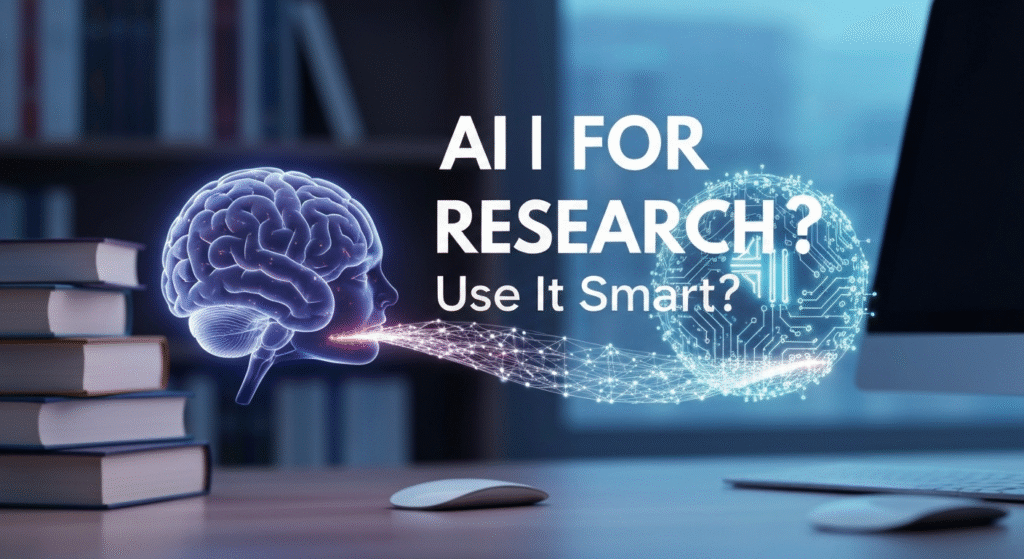Using AI for research projects is a hot topic on campus. It feels like every student is using it, or at least thinking about it. But here’s the thing: most of us are using it in a fog. We’re not sure what’s allowed, what’s smart, and what’s flat-out academic misconduct. It’s a powerful tool, no doubt. It can feel like a secret shortcut. But it’s also a minefield of fake information, ethical traps, and potential plagiarism.
The big problem is that most of us were never taught how to use it for research. We’re left to figure it out on our own. This often leads to stress, confusion, and sometimes, bad habits. This post is here to clear that fog. I’m going to break down exactly what I’ve learned from using AI for my own research projects. We’ll focus on the big three: credibility, citations, and ethical use. My goal isn’t to tell you not to use AI. It’s to show you how to use it as a smart, responsible assistant—not a crutch that will break.
As we dive in, it’s only fair to tell you where I’m coming from. My name is John Michael. For the past few years, I’ve been completely fascinated by AI and how it’s changing the way we find and process information. My work involves exploring these tools, figuring out what makes them tick, and translating the complex stuff into clear, simple terms. I spend a lot of time in the trenches, testing what works and what doesn’t. This isn’t about being a formal, certified expert; it’s about a deep curiosity and a passion for sharing what I find with others, especially students and fellow researchers.
The Big Question: Can You Really Use AI for Academic Research?

The short answer is yes. The longer, more important answer is: yes, but how you use it means everything.
Let’s get one thing straight. AI is not a “write my paper” button. If you use it that way, you are, at best, committing plagiarism and, at worst, submitting a paper filled with nonsense. The real value of AI is as an assistant. Think of it like a very fast, very knowledgeable, but sometimes unreliable research intern. It can speed up the tedious parts of research, but it can’t do the most important part: the thinking.
The core issue is understanding what an AI like ChatGPT or Gemini actually is. It’s a large language model (LLM). Its primary goal is not to be truthful; its goal is to be plausible. It’s designed to predict the next logical word in a sentence. This makes it amazing at sounding confident, summarizing text, and mimicking writing styles.
But a researcher’s goal is the opposite. Your goal is to find the truth, to be accurate, and to back up every claim with a verifiable source. When these two different goals meet, problems happen. The AI will confidently “predict” a fact or a source that sounds perfectly correct but is completely made up. This is the central challenge we have to manage.
Where AI Shines: My Go-To Uses in the Research Process

After a lot of trial and error, I’ve found that AI is fantastic for starting tasks and refining ideas. It’s a catalyst. It’s best used at the very beginning of your project and then again at the very end. Here’s how I use it.
Brainstorming and Refining Topics
This is, in my opinion, one of the best and safest uses for AI. We all start with a topic that is way too big. You might have “climate change” or “social media” as an idea. An AI is brilliant at narrowing this down.
My experience: I recently had a broad idea: “AI’s impact on education.” This is a huge, unmanageable topic. So, I gave the AI a specific role.
- My Prompt: “Act as a university sociology professor. My research topic is ‘AI’s impact on education.’ This is too broad. Can you generate 10 niche research questions on this topic that would be suitable for a 15-page undergraduate paper?”
- The Outcome: It gave me a fantastic list, including questions like:
- “How does the use of AI-powered tutoring apps affect math anxiety in 9th-grade students?”
- “What are the perceived ethical challenges of using AI for grading written assignments, according to high school teachers?”
- “Does personalized learning via AI platforms widen or narrow the digital divide in underfunded school districts?”
See? These are specific, debatable, and researchable. This took me from a foggy idea to a clear path in about 30 seconds.
Building Literature Review Outlines
A literature review is daunting. You have dozens of articles, and you need to organize them into themes. AI can create a roadmap before you even start reading. It helps you see the “shape” of the conversation.
- My Prompt: “I’m writing a literature review on ‘remote work and employee well-being.’ What are the common themes or sub-topics I should look for in the research?”
- The Outcome: The AI suggested a structure. It told me to look for themes like:
- Work-Life Balance and Blurring Boundaries
- Impact on Mental Health (Isolation vs. Flexibility)
- Physical Well-being (Ergonomics, Sedentary Work)
- Tools and Technology for Connection
- Managerial Challenges in Monitoring Well-being
This outline is now my “bucket system.” As I read real research papers, I can sort their findings into these categories. It saves hours of organizing.
Simplifying Complex Concepts
Let’s be honest: academic writing can be dense and nearly unreadable. Sometimes you’re staring at a paragraph from a journal article, and you just can’t figure out what it’s saying. AI is an amazing translator.
My process is simple. I’ll read a complex section from a paper. If I’m stuck, I copy and paste it into the AI.
- My Prompt: “Explain this paragraph to me like I’m a college freshman. Use a simple analogy if possible: [paste dense academic text here].”
- The Outcome: The AI will break it down. For example, I used this for a paper on ‘epigenetics.’ The AI explained it using an analogy of a light dimmer: “Your DNA is the light bulb (it doesn’t change), but epigenetics is the dimmer switch that controls how bright that light is (how your genes are expressed).”
This helped me understand the concept. Crucially, I do not use the AI’s words in my paper. I use my new understanding to write my own summary, and I cite the original paper.
Paraphrasing (With a Huge Warning)
This is a slippery slope, so listen closely. You should never paste text from a source, ask the AI to paraphrase it, and then put that in your paper. That is 100% plagiarism. Software can detect it, and your professor will know.
Here is the only safe way to use it for paraphrasing:
- Read your sources.
- Close them.
- Write your own notes and draft your paragraph in your own words.
- If your own paragraph sounds clunky or awkward, you can ask the AI to help you fix it.
- My Prompt: “Here’s a paragraph I wrote. Can you help me rephrase it to be more clear and concise? [Paste your own writing here].”
You are using it as a grammar assistant, not a writing replacement.
The “Danger Zone”: Credibility, Citations, and AI Hallucinations

This is the most important section of this article. If you learn nothing else, learn this: AI models invent information.
This isn’t a bug; it’s a feature of how they work. They are designed to generate plausible text. A plausible-sounding citation is just another string of text to them. This is called an “AI hallucination.” The AI will confidently make up facts, statistics, authors, journal titles, and entire studies.
The Critical Lesson: The AI Invented My Sources
I learned this the hard way, so you don’t have to. Early on, I was working on a research proposal. I was in a hurry. I asked the AI for “five key studies from the last 10 years on the impact of mindfulness apps on college student stress.”
It gave me a beautiful list. It looked perfect.
- Smith, J. (2019). “The Digital Zen…” Journal of American College Health.
- Chen, L. (2021). “Brief Mindfulness…” Computers in Human Behavior.
- …and three more.
They had authors, years, and real-sounding journal titles. I spent the next two hours in my university library’s database trying to find them. I found nothing. I searched for the authors. They didn’t exist. I searched for the articles. They didn’t exist.
Every single source was a complete fabrication.
This was the moment I realized the danger. If I had put those fake sources in my bibliography, I would have failed the assignment for academic fraud.
Why AI Fails at Citations
As I mentioned, an AI is a language model, not a research database. It does not “look up” information in a library. It has no access to Google Scholar or JSTOR.
When you ask it for sources, it doesn’t find them. It predicts what a string of text representing a “source” should look like. It knows a “Smith, J.” is often followed by a “(Year)” and then a “Title.” So it generates one. It’s just pattern matching, and it feels no shame in being wrong.
The “Trust, But Verify” Model Is Broken
For AI, the model is not “trust, but verify.” The model must be: “Never trust. Only verify.”
Assume every single fact, number, statistic, or claim an AI gives you is false until you can prove it’s true. This means you must:
- Take the claim from the AI (e.g., “remote work increases productivity by 15%”).
- Go to Google Scholar, your library, or another credible database.
- Find the actual, real study that supports this claim.
- Cite that real study in your paper.
If you cannot find a real source for the claim, you cannot use it.
A Practical Workflow: Using AI Ethically and Effectively
So, how do you put this all together? Here is a step-by-step process that keeps you safe and leverages the AI’s strengths.
Step 1: The Idea Phase (AI as Brainstormer)
This is the fun part. Have a conversation with the AI.
- Use it to narrow your topic.
- Ask it to play devil’s advocate: “What are the main counter-arguments to my thesis?”
- Use it to generate keywords you can use for your real search.
- Your Output: A clear research question and a list of keywords.
Step 2: The Research Phase (You, the Human)
This is the most important step, and the AI is not involved.
- Take your keywords to your university library database, Google Scholar, JSTOR, and other academic search engines.
- Find real papers, articles, and books.
- Read them. Take notes. Save your PDFs. This is the core of all research.
Step 3: The Synthesis Phase (AI as Sparring Partner)
Now you have a pile of notes from real sources.
- Use the AI to help you organize. “Here are my main findings from 10 papers […]. Can you help me group these into 3-4 logical themes?”
- Use it to overcome writer’s block. “I’m trying to connect the idea of ‘work-life balance’ with ‘managerial trust.’ Can you help me draft a transition sentence?”
- Your Output: A solid outline for your paper, based on your own research.
Step 4: The Drafting Phase (You, the Human)
Close the AI window. Open your word processor.
- Write the paper yourself. In your own words.
- Use your notes and your outline.
- Insert your citations as you write, linking back to the real PDFs you found.
- This is non-negotiable. Your voice, your analysis, and your arguments are what earn you the grade.
Step 5: The Editing Phase (AI as Proofreader)
After you have a complete draft, you can bring the AI back.
- Paste your writing (section by section) into the AI.
- Good Prompts: “Check this text for grammar and spelling errors.” “Is there any passive voice I can change to active voice?” “Does this paragraph flow logically?” “Suggest 3 alternative ways to phrase this one confusing sentence.”
- Your Output: A polished, clean final draft that is 100% your own work.
Comparing AI Tools for Research: What Works for What?
Not all AI tools are built the same. Using the right one for the right job is key. A general-purpose chatbot is great for brainstorming, but specialized tools are emerging for actual research.
Here’s a simple breakdown:
| Tool Type | Best For… | Key Limitation to Watch For |
| General LLMs (e.g., ChatGPT, Gemini) | Brainstorming, simplifying complex ideas, outlining, grammar checks. | High risk of “hallucinations.” Will invent facts and citations. NEVER use for finding sources. |
| Research-Specific AI (e.g., Elicit, Scite, ResearchRabbit) | Finding real papers, summarizing abstracts, finding connections between authors, checking if a paper has been supported or contradicted. | Can miss niche or very new research. It’s a search tool, not a thinking tool. You still must read the papers. |
| AI Writing Assistants (e.g., Grammarly, Wordtune) | Proofreading, checking grammar, improving sentence clarity, adjusting tone (e.g., “make this more formal”). | Will not check the accuracy of your facts or citations. It only checks the quality of the writing. |
| AI Paraphrasing Tools (e.g., QuillBot) | Rephrasing your own notes for clarity. | Extremely high risk of accidental plagiarism. Using this on a source text is academic misconduct. |
The Ethics Check: Staying on the Right Side of Your Professor
All the tips in the world don’t matter if you get an “F” for misconduct. Ethics are everything.
Rule 1: Always Check Your School’s Policy
This is the most important rule. Read your syllabus and your school’s academic integrity policy.
- Some professors and universities have banned all use of AI.
- Some allow it for specific tasks, like brainstorming or grammar checks.
- Some require you to disclose how you used it.
- The policy for your English class might be different from your Computer Science class.
- “I didn’t know” is never a valid excuse.
Rule 2: When in Doubt, Disclose
Honesty is your best protection. If you are unsure if your use of AI is acceptable, do one of two things:
- Don’t do it.
- Ask your professor first. Send a clear email: “Professor, I am planning to use an AI tool to help me brainstorm keywords and check my final draft for grammar. Is this acceptable under the course policy?”
If you do use it in an approved way, it’s good practice to add a short note at the end of your paper. (e.g., “I used ChatGPT to help generate initial topic ideas and to proofread my final draft for grammatical errors.”)
Rule 3: You Are 100% Responsible
This is the bottom line. You are the author. You are responsible for every single word, every fact, and every citation.
You cannot blame the AI. You can’t say, “ChatGPT gave me a fake source.” That’s like a carpenter blaming his hammer for a crooked nail. The AI is a tool. You are the one swinging it. If you submit a paper with fake information, you are the one who committed the academic misconduct.
FAQs: Using AI in Research
Is using AI for research considered plagiarism?
It can be. If you copy and paste AI-generated text into your paper without attribution, it is plagiarism. If you use it to paraphrase a source, it is also plagiarism. If you use it for brainstorming, outlining your own ideas, or checking your own grammar, it is generally not plagiarism (but you must still check your school’s policy).
Can AI help me find citations?
No. This is its biggest weakness. General AI chatbots (like ChatGPT) invent citations. You should use your university library, Google Scholar, or other academic databases to find your sources. You can use research-specific AI (like Elicit) to help your search, but you must still read and verify the papers.
What is the best AI for writing a research paper?
This is a trick question. The best person for writing a research paper is you. The best AI is one that assists you. Use a general AI for ideas and grammar. Use a research-specific AI to help you search for real papers.
How can I fact-check information from an AI?
Treat every claim as “unverified.” Copy the claim and paste it into Google. Look for credible, primary sources that back it up. A good source is usually a published study, a report from a government agency (.gov), a major news organization with a good reputation, or a university website (.edu). If you can’t find a credible source, the claim is false.
Final Thoughts: The AI-Assisted Researcher
Using AI in research isn’t a simple “yes” or “no.” It’s not a threat to good research; it’s a multiplier for it. But only if you use it with your eyes wide open.
What I’ve learned is that AI is fantastic at handling the “grunt work.” It can organize, it can summarize, and it can help you get unstuck. This frees up your brain to do the work that actually matters: the critical thinking, the analysis, the connecting of ideas, and the creation of new insights.
The future of research isn’t AI versus humans. It’s AI-assisted humans. Be the smart, ethical researcher who knows how to use the tool without letting the tool use you.


